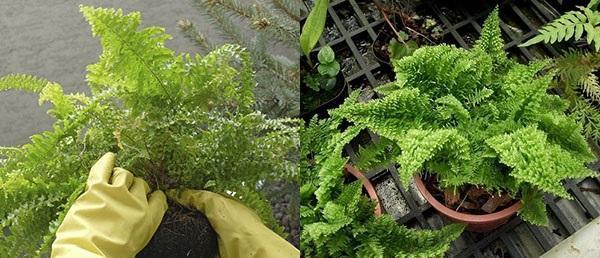Nephrolepis transplant from store substrate
 After buying a plant, he is given about a month to adapt to a different microclimate. Then a mandatory transplant of nephrolepis into a large pot, as well as into a new substrate, is carried out. Moreover, it is necessary if the culture has a morbid appearance. This often happens even with timely care and watering. The reason for this is the transport soil, which is able to retain moisture for a long time. As a result, the roots just start to rot.
After buying a plant, he is given about a month to adapt to a different microclimate. Then a mandatory transplant of nephrolepis into a large pot, as well as into a new substrate, is carried out. Moreover, it is necessary if the culture has a morbid appearance. This often happens even with timely care and watering. The reason for this is the transport soil, which is able to retain moisture for a long time. As a result, the roots just start to rot.
Many gardeners recommend choosing clay containers for the shrub. They are especially suitable for winter. This is a porous material that allows the pot to breathe. Moreover, water dries out quickly in it. In the spring, they do the transfer into plastic.
Nephrolepis transplant required
After the grower takes the seedling out of the pot, he removes a little peat with an earthen coma. Looks at the condition of the roots. Removes damaged processes, as well as dried fronds. Drainage is placed on the bottom of the disinfected pot. It can be made not only from expanded clay, but also from pieces of foam. For transplanting nephrolepis, the following soil composition is used:
- universal soil (2 parts);
- a few handfuls of coco soil (based on coconut fibers);
- charcoal 3-5 tablespoons.
Using a spatula, carefully break the seals in the planting substrate and mix. Fill the reservoir up to half with earth. Try on a seedling. Then they cover it with the remaining soil mixture. Finally, moisturize the young shrub abundantly. When the water drains through the drainage hole, the pot is placed on a stand and sent to its permanent residence.
Do not deepen the root collar too deep, otherwise the fern will slowly develop and eventually rot.
What does the plant like?
The shrub prefers bright, but diffused light. Amazingly takes root in light shade. Prolonged stay in dense thickets leads to the fact that he begins to be seriously ill. Also, nephrolepis does not tolerate large pots, because in areas not filled with roots, the earth begins to sour. This, in turn, has a bad effect on the vital activity of the rhizome.
In the autumn-summer period, the culture needs feeding. Fertilizers are used for decorative leafy flowers or specifically for ferns. Since they have a delicate root system, complex preparations are diluted in a 1: 4 ratio. In winter, such procedures are not carried out.
It should be borne in mind that nephrolepis is experiencing a bad transplant. Therefore, it is not worth it too often. It is better to propagate the crop using long shoots from the rhizome. However, this is already another chapter of an amazing story.